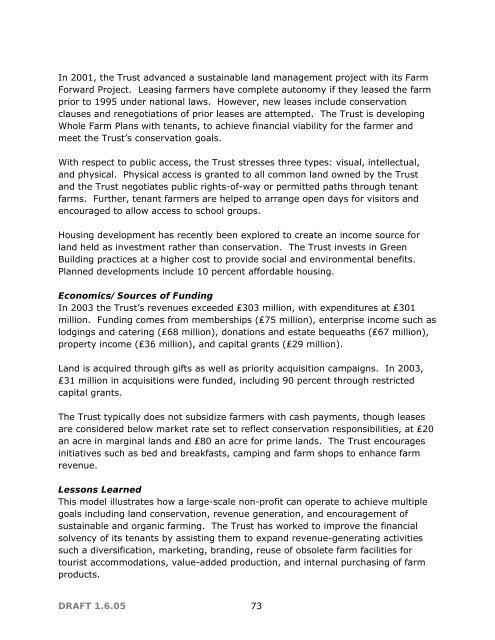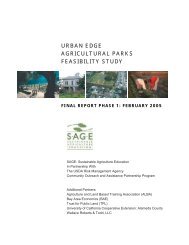National Trust, United KingdomThis model describes a national non-profit approach to preserving the cultural andagricultural resources of the United Kingdom.Background and PurposeFounded in 1885 by three philanthropists concerned with protecting lands fromdevelopment and industrialization, the National Trust is charged with looking afterits properties “<strong>for</strong>ever, <strong>for</strong> everyone.” The Trust works to preserve and protect thecoastline, countryside, and buildings of England, Wales and North Ireland byacquiring and managing properties in fee title. Under a Farming Forward program,the National Trust helps build a sustainable future <strong>for</strong> farmers throughenvironmentally friendly land management, support of local food initiatives,education, and adding value to local products.Properties are located throughout the United Kingdom. Acquisition does notconsider proximity to urban environments but rather “cultural, environmental,historic, environmental or aesthetic importance.”LandThe National Trust owns more than 615,000 acres of land, including 346,000 acresof farmland. As a non-profit organization, the Trust owns all land in fee. Farmersand ranchers either lease entire farms under Trust ownership, or lease portions ofestates <strong>for</strong> farming or grazing. Farmers independently manage crops and lands.The Trust encompasses approximately 2,000 farmers, with 700 renting entirefarms, 1,300 renting a portion of an estate, and additional farmers accessingcommon land on 66,000 acres. Over 60 professional land agents work <strong>for</strong> theTrust, assisting tenant farmers.Target Producers/CropsSixty percent of the Trust’s farmland is in upland areas where livestock farmingpredominates, sometimes under harsh conditions. The remaining 40 percent offarms are in lowland settings, farmed primarily as dairies and “arable” landsincluding one hops grower.Farming Practices/EnvironmentalConservationLess than two percent of Trust farms are organic, but another four percent areplanning to convert to organic practices. At this rate, 20 percent of Trust land couldbe organically farmed by 2010, but the vast majority is expected to remainconventionally farmed. The Trust offers technical advice and assesses vacant farms<strong>for</strong> organic conversion through the Elm Farm Research Center.DRAFT 1.6.05 72
In 2001, the Trust advanced a sustainable land management project with its FarmForward Project. Leasing farmers have complete autonomy if they leased the farmprior to 1995 under national laws. However, new leases include conservationclauses and renegotiations of prior leases are attempted. The Trust is developingWhole Farm Plans with tenants, to achieve financial viability <strong>for</strong> the farmer andmeet the Trust’s conservation goals.With respect to public access, the Trust stresses three types: visual, intellectual,and physical. Physical access is granted to all common land owned by the Trustand the Trust negotiates public rights-of-way or permitted paths through tenantfarms. Further, tenant farmers are helped to arrange open days <strong>for</strong> visitors andencouraged to allow access to school groups.Housing development has recently been explored to create an income source <strong>for</strong>land held as investment rather than conservation. The Trust invests in GreenBuilding practices at a higher cost to provide social and environmental benefits.Planned developments include 10 percent af<strong>for</strong>dable housing.Economics/Sources of FundingIn 2003 the Trust’s revenues exceeded ₤303 million, with expenditures at ₤301million. Funding comes from memberships (₤75 million), enterprise income such aslodgings and catering (₤68 million), donations and estate bequeaths (₤67 million),property income (₤36 million), and capital grants (₤29 million).Land is acquired through gifts as well as priority acquisition campaigns. In 2003,₤31 million in acquisitions were funded, including 90 percent through restrictedcapital grants.The Trust typically does not subsidize farmers with cash payments, though leasesare considered below market rate set to reflect conservation responsibilities, at ₤20an acre in marginal lands and ₤80 an acre <strong>for</strong> prime lands. The Trust encouragesinitiatives such as bed and breakfasts, camping and farm shops to enhance farmrevenue.Lessons LearnedThis model illustrates how a large-scale non-profit can operate to achieve multiplegoals including land conservation, revenue generation, and encouragement ofsustainable and organic farming. The Trust has worked to improve the financialsolvency of its tenants by assisting them to expand revenue-generating activitiessuch a diversification, marketing, branding, reuse of obsolete farm facilities <strong>for</strong>tourist accommodations, value-added production, and internal purchasing of farmproducts.DRAFT 1.6.05 73
- Page 1 and 2:
DRAFTURBAN EDGEAGRICULTURAL PARKSFE
- Page 3 and 4:
EXECUTIVE SUMMARYOverview of AgPark
- Page 5:
Farmworker Housing on the Rural/Urb
- Page 10 and 11:
seeking to develop effective collab
- Page 12:
INTRODUCTIONHistory of Collective F
- Page 15 and 16:
Contemporary Models of Agricultural
- Page 17 and 18:
accommodations, value-added product
- Page 19 and 20:
45%, from 5,347 in 1997 to 7,771 in
- Page 21 and 22:
information about each site include
- Page 23 and 24: undertaken. It may be best to furth
- Page 25 and 26: IDENTIFICATION OF POTENTIAL AGPARK
- Page 27 and 28: SONOMA COUNTYLaguna Farm 80-acre 3
- Page 29 and 30: The above examples reflect a range
- Page 31 and 32: MARTIAL COTTLE PARK FEASIBILITY STU
- Page 33 and 34: Median household income in the neig
- Page 35 and 36: • Relationship to surrounding nei
- Page 37 and 38: • Education/Research Center: 4-H,
- Page 39 and 40: Management and DevelopmentRole of S
- Page 41 and 42: Beyond the capital costs for the in
- Page 43 and 44: ConclusionThis property has great p
- Page 45 and 46: Ardenwood Historic Farm is the rema
- Page 47 and 48: • Establish Ardenwood as a vibran
- Page 49 and 50: These ideas complement and build on
- Page 51 and 52: • Farmer Housing: None proposed.
- Page 53 and 54: ConclusionsThis project identified
- Page 55 and 56: Appendix A: Overview of Ag Park Mod
- Page 57 and 58: The National Trust(England, Wales,N
- Page 59 and 60: Crystal Waters Village(Malaney, pop
- Page 61 and 62: McBryde AgriculturalPark (Kauai, HI
- Page 63 and 64: Farm worker Housing on Rural/Urban
- Page 65 and 66: Occidental Arts& EcologyCenter(Occi
- Page 67 and 68: The FarmSchool (Athol,MA)Privatelyo
- Page 69 and 70: To ensure conservation in perpetuit
- Page 71 and 72: King County FarmlandPreservation Pr
- Page 73: development.Economics/Sources of Fu
- Page 77 and 78: LandThe cooperatives have sought la
- Page 79 and 80: ALBA’s Farm Training andResearch
- Page 81 and 82: • “ALBA Organics” distributio
- Page 83 and 84: in addition to herbs, flowers, and
- Page 85 and 86: APPENDIX C: FUNDING SOURCES FOR AGP
- Page 87 and 88: Public Support for FarmlandPreserva
- Page 89 and 90: transactions. Transaction types wil
- Page 91 and 92: Affordable Rural Housing Grant andL
- Page 93 and 94: farm" program, established farmers
- Page 95 and 96: Appendix D: Producer Survey Instrum
- Page 97 and 98: 12. Would you be interested and wil
- Page 99 and 100: Feasibility Study for Urban Edge Ag
- Page 101: Site BLocationFremont, adjacent to





